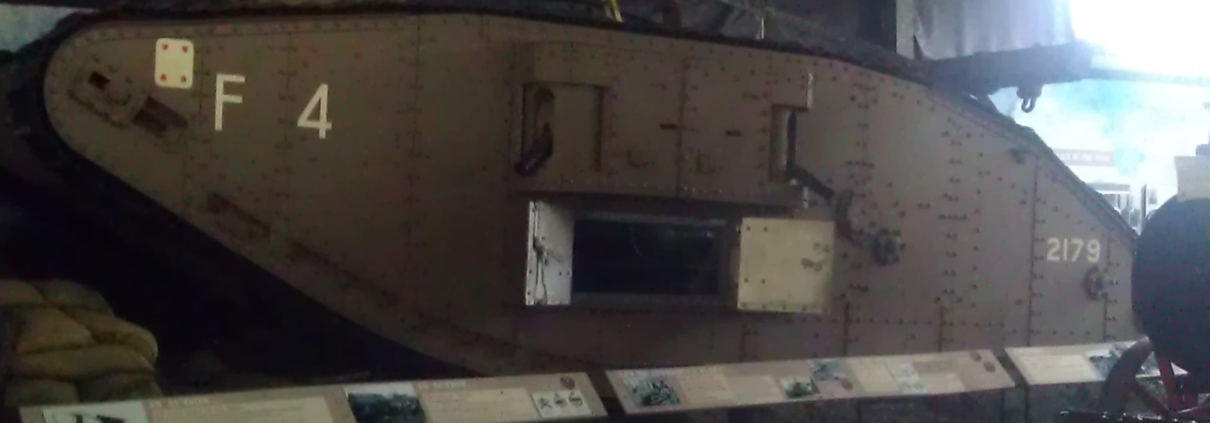The Worst Tank in the World?
(This picture is not the Ajax vehicle we’re discussing here of course. It is my photograph of one of the earliest tanks ever made, now in the Museum of Lincolnshire Life in Lincoln, the city where the world’s very first tank was designed, in a meeting room at the White Hart hotel).
The story of the Ajax armoured fighting vehicles (small tanks, if you like), bought for the British Army from US defence firm General Dynamics, looks like it will be a lengthy case study if I do produce a follow up to my first Bad Buying book.
Wasting a fortune as in this case is by no means a unique occurrence for the military, and we have seen similar disasters in many countries, as equipment turns out to be far more expensive than planned or fails to provide the capability that was desired. Sometimes, both of those failings are present.
In the case of Ajax, the General Dynamics solution was chosen in 2010 and the contract agreed in 2014. The first vehicles should have been delivered in 2017, and the first British Army squadron should have been using them by mid-2019. However, problems emerged during testing. For instance, the vehicles were so noisy that crews were required to wear noise cancelling headphones and be checked for hearing loss at the end of operations.
The Times reported expert opinion that problems with Ajax were so serious, the government should consider cancelling the £5.5 billion deal to buy 589 of the vehicles. So far, the vehicles have cost £3.2 billion despite only 14 being delivered — all without a turret and of odd sizes. A leaked report by the Government’s own Infrastructure and Projects Authority, which reports to the Cabinet Office, says that the problems with the Ajax vehicle do not seem to be manageable or resolvable within the agreed costs and timescale.
Recently it was revealed that trials of the Ajax armoured vehicle were halted from November 2020 to March 2021. Then trials were paused again in mid-June on “health and safety grounds” amid concerns that mitigation measures put in place to protect soldiers — including ear defenders — were not sufficient. Excessive vibration and noise meant crews suffered from nausea, swollen joints and tinnitus, and soldiers were only allowed 105 minutes inside the vehicle, with a maximum speed of 20 mph (32 km/h).
Not very good in a real-life conflict, really. “Could you stop shooting at us, we have to let our chaps out for a bit of a rest now, they’ve been in there almost 2 hours!” Amazingly, suspension issues also mean that the turrets could not fire while the vehicle was moving, and vehicles were unable to reverse over obstacles more than 20 cm high. I think even my Kia could manage that – we’re getting into the territory of “you have to laugh really, or you would cry”.
Another element of the Ajax story which would be amusing if the whole programme weren’t such a huge waste of public money came last week when the public announcement of the latest problems was made during the England versus Germany football match! Talk about timing a bad news story to avoid public focus.
Tobias Ellwood, chairman of the defence select committee, said that the vehicle’s weight had ballooned to 42 tonnes after many redesigns. It was now “heavier than any tank during the Second World War”, he said. Some observers have suggested senior officers in the army may have hidden the extent of the problem over recent months to prevent it being axed as part of the government’s Integrated Defence Review.
But there is some debate about the underlying causes of this fiasco. There are claims that there was a “anyone but BAE Systems” view in the military when the supplier was being chosen. Private Eye and The Times also suggested that General Dynamics just said “yes” to everything the Army wanted, without really being able to provide it. “They went to General Dynamics and said ‘Can you do it?’ and they said yes”.
But others see the fault sitting with the military, with the specification being continually changed and made more complex over the years, leading to that issue with the weight of the vehicle, as Ellwood pointed out.
Bernard Gray, who was Chief of Defence Material from 2011-16, has published some interesting comments on Twitter recently. He suggests that the initial contract was fine, which might be understandable as his team must have been very involved in that phase. But changes to the specification driven by the Army after contract signature, on what should have been a fixed price, fixed spec contract, are behind the problems, he suggests. Gray said this; “I don’t think that’s true if the product was not fit for purpose. The problem was, how much had MoD deviated from the 2014 contract by 2019… that’s what we need to explore”.
If that diagnosis is correct, it may prove hard to recover money from General Dynamics. If the firm has simply done what it was asked or required to do by the customer, we can hardly blame it if the end product doesn’t work.
Another thread on Twitter related to the decision by the Australian army not to select the Ajax product. Apparently, that was because when they took up references from the British army in 2019, they were told to avoid it.
It is all a huge mess anyway, not just financially but also operationally, as this is a pretty essential and fundamental piece of kit for our soldiers. As usual, the taxpayer takes the hit, and as usual we will never find out exactly who should carry the can for this in the military, civilian MOD or political worlds, or indeed on the supply side. Will anybody get fired? You must be joking. Strangely enough, it always seems impossible to place the responsibility for Bad Buying in the public sector on anyone in particular.








